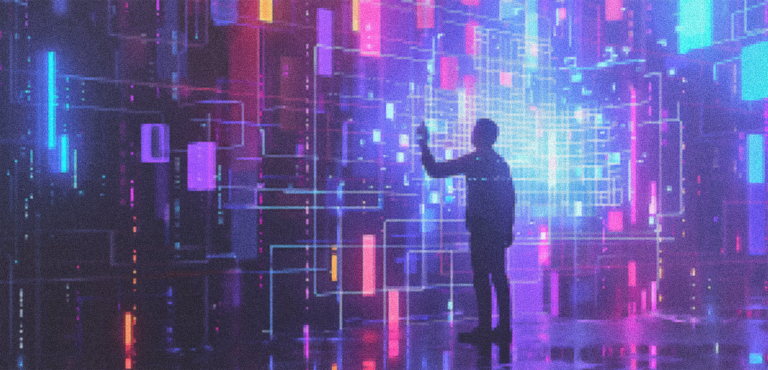
Beyond Headset: Spatial Computing’s Expanding Reach in IT
Spatial computing has expanded beyond gaming or entertainment. In the IT sector, it is revolutionising the way we work, collaborate, and innovate. Spatial computing merges the physical and digital worlds, driving changes in software development and IT management. In 2025, this technology is more than a trend; it’s a major step forward for the industry.
Spatial computing naturally blends the digital and physical worlds, creating immersive and interactive experiences. This technology uses advanced sensors, AI, and real-time processing to map environments and overlay digital information onto them. In IT, it’s transforming workflows, collaboration, and data management. AR glasses, VR headsets, and mixed-reality devices help teams troubleshoot, visualize data, and train in virtual spaces. With lighter hardware, better AI, and improved security, spatial computing will be essential for IT professionals in 2025.
Products and platforms leading the spacial computing revolution
Several major tech companies are driving spatial computing innovation in the IT space:
- Microsoft HoloLens 2: Widely used in IT and engineering, HoloLens 2 enables remote collaboration, 3D modelling, and hands-free workflows. IT teams can visualise network layouts and troubleshoot hardware in real-time, boosting productivity and reducing on-site needs.
- Apple Vision Pro: Released in 2024, Apple’s spatial computing headset has already begun redefining how IT professionals manage projects. Vision Pro sets a new standard for AR-powered productivity tools with intuitive interfaces for coding, debugging, and system monitoring.
- Meta Quest Pro: IT teams are adopting Meta’s advanced VR headset for virtual meetings, training, and collaborative coding. Distributed teams can work together as if they were in the same room, bridging geographical gaps.
- Lenovo ThinkReality: Lenovo’s AR solutions are tailored for enterprise IT. They offer tools to manage data centres and guide technicians through complex setups with AR overlays. These overlays provide step-by-step instructions, improving accuracy and efficiency.
- Google ARCore: Google’s AR platform helps IT teams create custom solutions like network visualization, system management, and augmented training. ARCore’s flexibility allows organisations to create bespoke applications tailored to their needs.
- Magic Leap 2: Magic Leap 2’s lightweight design makes it popular in IT for system visualisation, simulations, and remote collaboration. Its open platform supports integration with various IT workflows.
- Unity and Unreal Engine: Software platforms like Unity and Unreal Engine are key for creating custom spatial computing applications. IT professionals use these tools to design AR/VR environments for network management, cybersecurity training, and more.
How spatial computing enhances IT
Spatial computing has unlocked a range of applications in the IT sector:
Remote collaboration: Platforms like HoloLens 2 and Meta Quest Pro allow IT teams to collaborate in virtual environments. Team members can review 3D network diagrams or software architecture in real-time, regardless of location.
Data visualisation: IT professionals can use AR to project complex data sets into 3D spaces, making it easier to identify patterns, diagnose issues, and present findings to stakeholders. This is particularly valuable for network monitoring and cybersecurity analysis.
Training and onboarding: Spatial computing provides immersive training environments for new IT staff. VR simulations allow employees to practise configuring servers or managing incidents without risking downtime.
Infrastructure management: AR platforms like ThinkReality help IT technicians navigate data centers by overlaying critical information onto equipment. This includes rack layouts and hardware health data for improved management.
Prototyping and development: Developers use spatial computing tools to build and test applications in virtual environments. For example, UI/UX designers can prototype software interfaces in 3D, ensuring a more intuitive user experience.
What to expect in 2025
The IT sector is set to see significant advancements in spatial computing this year. Here’s what we can anticipate:
- Lighter, affordable hardware: AR glasses and VR headsets will become more compact and affordable, broadening access for IT professionals.
- AI-driven enhancements: Spatial computing will integrate AI for predictive analytics, automated troubleshooting, and improved virtual interaction.
- Broader digital twin adoption: IT teams will use spatial computing for real-time monitoring and optimisation through digital twins of networks and systems.
- Standardisation across platforms: As spatial computing matures; standardised tools and protocols will enable seamless IT integration.
- Increased security focus: IT security teams must address new challenges, such as protecting AR overlays and VR environments from cyber threats.
Distilled
Spatial computing is revolutionising the IT sector, offering new ways to collaborate, innovate, and manage complex systems. As we navigate 2025, the technology’s potential to enhance productivity and streamline operations is becoming increasingly evident. With leaders like Microsoft, Apple, and Google driving the change, it’s set to transform IT workflows and bridge physical-digital gaps.